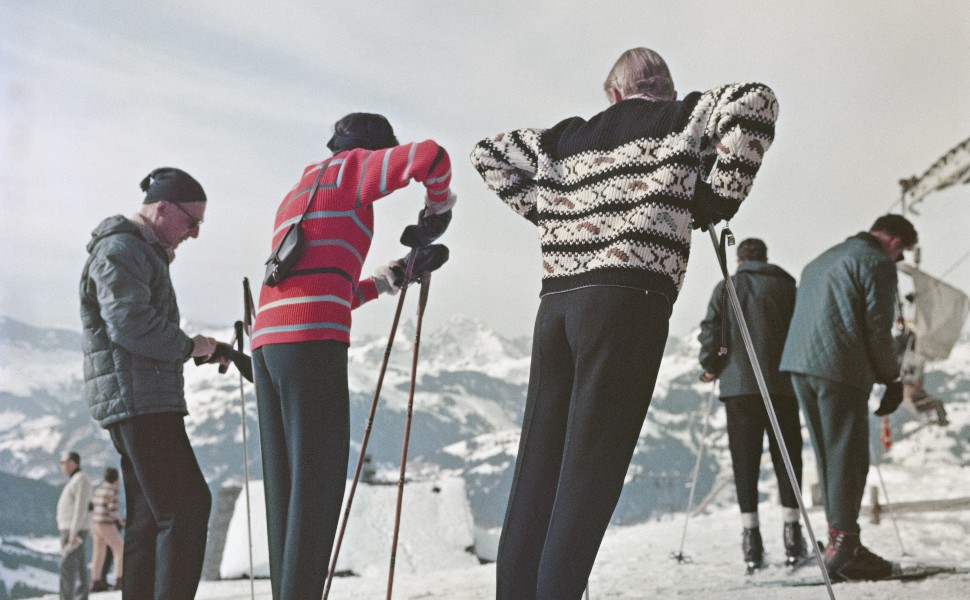
The actress Julie Andrews once described Gstaad as “the last paradise in a crazy world”. This sentiment captures the essence of a village that has preserved its charm while evolving into a cultural hotspot. Originally a haven for farmers and cattle herders, Gstaad has transformed into a sought-after destination, captivating visitors with its Alpine beauty, refined boutiques, gourmet dining, and luxury hotels. Even as it continues to flourish, Gstaad remains a serene sanctuary amidst the fast pace of modern life.
The construction of the Montreux-Oberland Bernois (MOB) railway in 1905 marked a turning point in Gstaad’s history. This new rail connection opened the village to affluent European families, drawn by its idyllic scenery and mountain air. It signalled the region’s transformation from an agrarian society to a rising tourist destination. However, it was the pioneering hotelier families who truly shaped Gstaad’s identity, taking risks to turn the farming village into an exclusive haven. Among Gstaad’s first hotels were the Post-Hostel Rössli (1845), The Olden (1899), and the Grand Hotel Alpina (1907). However, it was the Gstaad Palace, opened in 1913 by local schoolteacher Robert Steffen, that firmly established the village’s reputation. Overcoming challenges like World War I and the Great Depression, the Palace thrived by the 1920s. The Scherz family took over in 1947, and under Ernst Andrea Scherz, the 1950s and 1960s saw stars like Grace Kelly, Elizabeth Taylor, and Roger Moore visit Gstaad, solidifying its status as a world-class destination.
While the Palace garnered international attention, the Grand Hotel Alpina had already begun its own journey of refined hospitality. Opened in 1907, it remained a fixture in Gstaad until the 1980s, when its prominence began to fade. In the 1990s, Gstaad native Marcel Bach and long-time visitor Jean-Claude Mimran acquired the property and envisioned a new era for it. The original building was demolished in 1995, and after thoughtful revisions and community discussions, construction began in 2008. The Alpina Gstaad finally opened its doors in December 2012, celebrated with a gala attended by Prince Albert II of Monaco, marking the first new hotel of its calibre in 100 years.
In the 1950s and 1960s, Gstaad emerged as a premier winter sports destination, attracting celebrities and filmmakers. Stars such as Richard Burton, Elizabeth Taylor, Julie Andrews, and Roger Moore flocked to the village, further enhancing its reputation as a discreet retreat for the elite.
Gstaad’s cinematic appeal began with Denys de La Patellière’s “Thérèse Étienne” (1958), set against the snow-covered landscapes of Gstaad and Lauenen. The film’s Alpine backdrop intensified the emotional tension of its story. Later, Gstaad Palace appeared in Blake Edwards’ “The Return of the Pink Panther” (1975), with its exterior serving as the villain’s hideaway. Edwards and his wife, Julie Andrews, became frequent visitors to Gstaad, and Andrews eventually became an honorary citizen in 2014, dedicating a “sitting duck” statue to the town.
More recently, Gstaad has featured in films, including Bollywood “Dilwale Dulhania Le Jayenge” (1995), as well as in “Un nemico che ti vuole bene” (2018) by Denis Rabaglia. Roman Polanski’s “The Palace” (2023) used the grandeur of Gstaad Palace to satirise the extravagant lives of the elite, continuing the village’s enduring cinematic presence.
Literature has also played a role in shaping Gstaad’s image. Although Ernest Hemingway never wrote specifically about the village, his frequent stays in the Swiss Alps influenced his depiction of mountains as places of solitude and beauty. F. Scott Fitzgerald, however, paid homage to Gstaad in “Tender Is the Night” (book 2, 1934), where a significant chapter unfolds in the village, culminating in the memorable line: “Good-bye, fresh faces, cold sweet flowers, flakes in the darkness. Good-bye, Gstaad, good-bye!”
Gstaad also features in contemporary literature, such as Arnon Grunberg’s “Gstaad 95-98” (2002), which explores the struggles of a sommelier within the village’s elite circles. Maryse Deseigne’s “Vacances à Gstaad” (2018) contrasts Saanen’s peaceful setting with the wartime memories of its protagonist, Heather.
Celebrity memoirs further affirm Gstaad’s allure. Roger Moore, who lived in the village for many years, described it as a peaceful retreat in his memoir “My Word Is My Bond” (2008). Moore reflects on Gstaad as a haven where he found privacy and solace, enjoying simple pleasures far from the pressures of fame.
Today, Gstaad’s literary appeal continues through the World of Words (WoW) festival, founded in 2020. The festival has brought together authors like Mick Herron, Jay McInerney, Louise Doughty and Frédéric Beigbeder, further enriching Gstaad’s cultural landscape and reinforcing its status as both a refuge and a literary sanctuary.